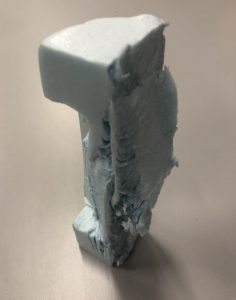“We’re constantly crafting and re-crafting it. Then it produces errors, mistakes, breakdowns, glitches, noise, and from a computer science perspective, what you would want to do would be debugging and refining. But from a dirty new media perspective, what you might want to be doing is “rebugging,” and pushing different aspects of the machine worlds to see their thresholds, and experiment, and play.” -Jon Cates
We destroy something, so we can expand on existing meanings and intent, bringing it to life.
In destroying the main, physical objective values inherently identifying the object, we liberate it from the expectations and functions the modern world ascribes to it. Just like how Ant farm took the original message of capitalism and consumerism and uprooted them in Cadillac ranch, we attempted to create an usurpation of meaning through foam.
For this project, we set blue foam as the target for destruction.
We broke down our destruction into 5 parts: each act of destruction sinking deeper from surface level to destroying the foam’s very core and integrity.
We chose blue foam, a material which is very malleable to destroy. In all its flexibility, the blue foam is able to be cut and crafted to the designer’s will. But it still retains its autonomous identity. I seek to destroy the foam in such a way that its pre-existing identity is gone, and in its place, a new meaning shall take its place.
In the first stage, we used a chisel, scratching and goring away the surface of the foam. We make indents like scars, reflective of how we attempt to remove the outer skin of meanings and judgements associated with the foam.
In the second stage, we stabbed into the foam with the chisel. Striking at random intervals, we gored deep and shallow into the foam, piercing through layers.
In the third stage, we made use of the indentations, groves and scars of the previous stages a nd physically broke the blue foam over its line of weakness. Brute strength allowed us to rip the foam apart, as if tearing at its very fabric of its nature.
In the fourth stage, we used superglue to corrode the chemical structure of the foam, further disintegrating its identity.
N the fifth stage, we clamped the foam and continued turning the lever, using mechanised brute force to compress the very air inside the foam, deforming it (or is it deFOAMING it? Hehe) Its as if we crushed the very spirit and essence of the foam.
We filmed the entire process shakily, infusing breathiness and constant jittering instability. We also filmed it on time lapse, destroying the sense of time and event of physically destroying the foam. We also added glitch effects to the last part of the video, distorting it and making the foam unnoticeable and much different from its original form. This brings to mind a message from the Glitch Manifesto, encouraging people to embrace new meanings through glitch: “The gospel of glitch art also tells about new norms implemented by corruption”
Through the video and the process, the foam is no longer is inherent integrous state, it has been destroyed and transformed into something not like itself.
We are not sure what the final creation is. To an objective bystander’s point, it is no longer a functional piece of foam and is considered trash. To an artist, its unique curvatures and marks of abuse may term it art. To each their own. What we have learnt is that through destruction, the foam has been liberated from its original intended purpose and can search for new meaning.
